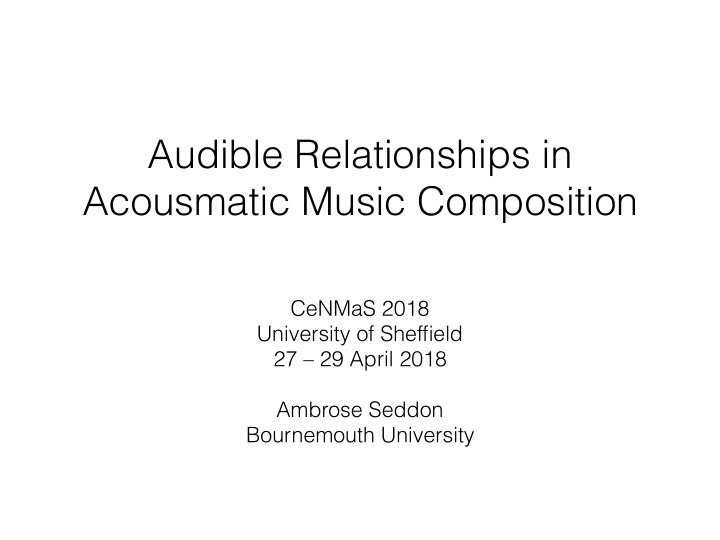



Audible Relationships in Acousmatic Music Composition CeNMaS 2018 University of Sheffield 27 – 29 April 2018 Ambrose Seddon Bournemouth University
Introduction • “Musical structure depends on establishing audible relationships amongst the sound materials” of a musical work (Wishart 1994) • This presentation: • My own ideas around audible relationships • Explorations is my own work • Merits/difficulties of adopting these ideas
Questions • How are sounds related when listening to a work? • How to create such relationships when composing? • And how might they operate over the various timescales of a composition? • Largely focus on the first two today • Looking at recurrent phenomena
Some definitions • Acousmatic music • “Music where (in live performance) the sources and causes of the sounds are invisible – a music for loudspeakers alone” (Smalley 1997) • A culture of practice evolving from Pierre Schaeffer’s musique concrète
Recurrence • “Audible relationships” founded on recurrence • “sound materials that refer back to earlier related instances” (Seddon 2013) • Degrees of similarity • apparent sameness to just vestiges of resemblance.
Some important factors • Listener must notice sounds in first place • Strong identity • Context within the work • What else is happening?
Pellere (2012) • An 8-channel acousmatic work • Loudspeakers surround the listening area • Listen 0 – 1’20
Source recordings • Aiming for distinct sound shapes • Violin and cello • Striking identities • Sounds to sculpt into striking identities • String-ness not the core theme of the music
ID1 - Bounces • Instrumental gestures • Natural acceleration • pitch and noise elements • Like a micro-composition • Listen
Bounce family • Some processing • Spectral contrast • Enhance pitch content • Spectral warp • reconfigure spectrum • Delays • Reshape the sound (to a degree…)
ID2 - Descents • Various manifestations • slow-onset/slow-decay sound-shape • descending pitch and spectral sweeps • Sound shape more important than source (for me) • Listen (3)
Descent family • Family variability based around changes in: • register • speed of morphological evolution • position around the listener (circumspace (Smalley 2007)) • proximity to the listener - filtering (duller sounds seem further away)
ID3 - Pulses/iterations • Violin sound source • sound family • original gestures are NOT left in-tact, • identities are shaped by the sound processing
Pulse/iteration family • Granular synthesis • Pulses • to drive the music forward • a common morphology • Spectrally contrasting instances • Different spatial zones around the listener • 13.5 Hz!
The Opening • Listen
Final comments • Ideas useful but… • Hard to work in a prescriptive way • Informs approach
Bibliography Harrison, Jonty. 2005-6. Internal Combustion . Environs. Empreintes Digitales: IMED 0788, 2005-6. Schaeffer, Pierre, Christine North, and John Dack. 2017. Treatise on Musical Objects: An Essay across Disciplines . 1 ed: University of California Press. Seddon, Ambrose. 2013. Recurrence in acousmatic music . Doctoral, Centre for Music Studies, City University London. Smalley, Denis. 1997. Spectromorphology: explaining sound-shapes. Organised Sound 2 (2):107-126. Smalley, Denis. 2007. Space-form and the acousmatic image. Organised Sound 12 (1): 35-58. Wishart, T. 1994. Audible Design: A Plain and Easy Introduction to Practical Sound Composition . York: Orpheus the Pantomime.
Recommend
More recommend